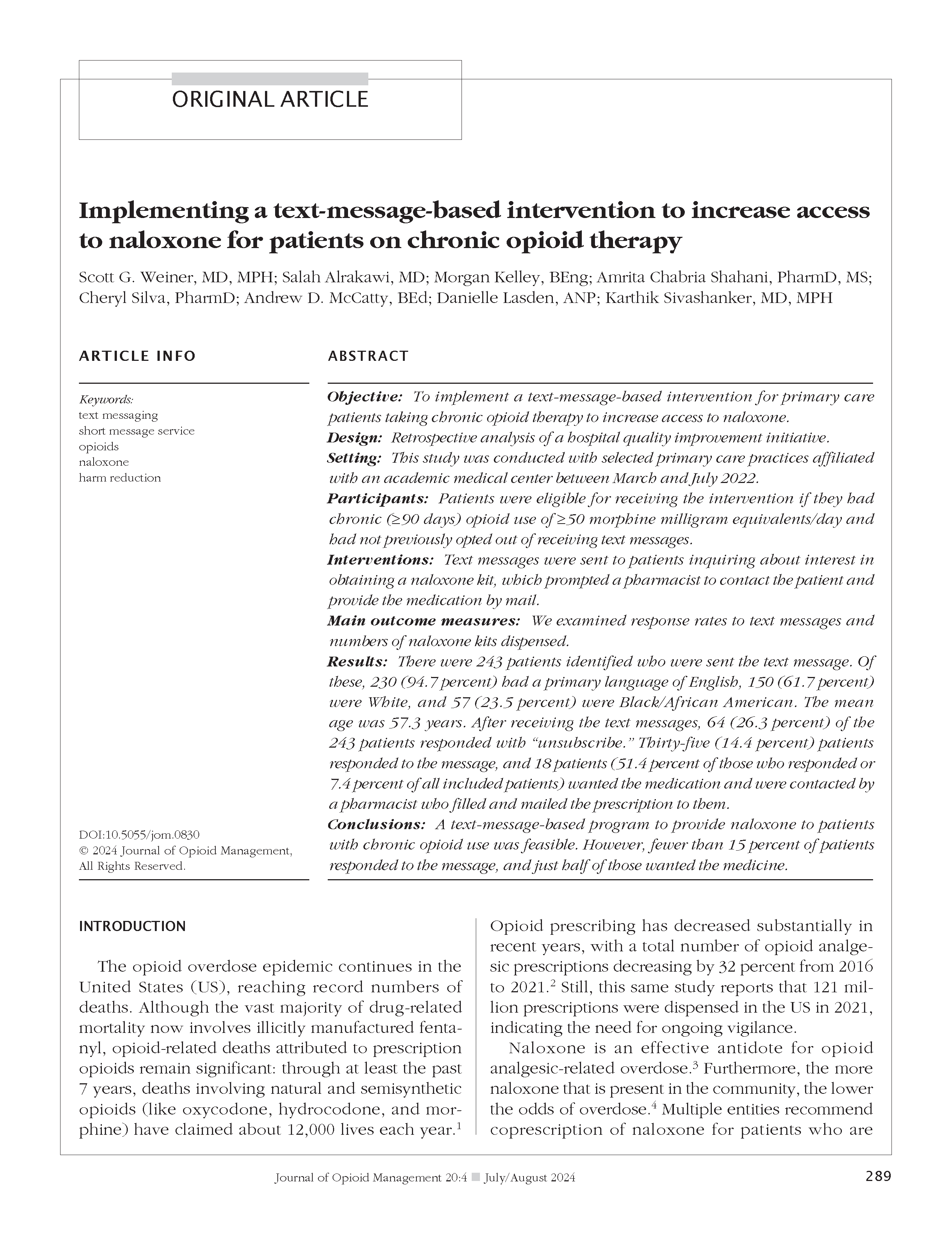Implementing a text-message-based intervention to increase access to naloxone for patients on chronic opioid therapy
DOI:
https://doi.org/10.5055/jom.0830Keywords:
text messaging, short message service, opioids, naloxone, harm reductionAbstract
Objective: To implement a text-message-based intervention for primary care patients taking chronic opioid therapy to increase access to naloxone.
Design: Retrospective analysis of a hospital quality improvement initiative.
Setting: This study was conducted with selected primary care practices affiliated with an academic medical center between March and July 2022.
Participants: Patients were eligible for receiving the intervention if they had chronic (≥90 days) opioid use of ≥50 morphine milligram equivalents/day and had not previously opted out of receiving text messages.
Interventions: Text messages were sent to patients inquiring about interest in obtaining a naloxone kit, which prompted a pharmacist to contact the patient and provide the medication by mail.
Main outcome measures: We examined response rates to text messages and numbers of naloxone kits dispensed.
Results: There were 243 patients identified who were sent the text message. Of these, 230 (94.7 percent) had a primary language of English, 150 (61.7 percent) were White, and 57 (23.5 percent) were Black/African American. The mean age was 57.3 years. After receiving the text messages, 64 (26.3 percent) of the 243 patients responded with “unsubscribe.” Thirty-five (14.4 percent) patients responded to the message, and 18 patients (51.4 percent of those who responded or 7.4 percent of all included patients) wanted the medication and were contacted by a pharmacist who filled and mailed the prescription to them.
Conclusions: A text-message-based program to provide naloxone to patients with chronic opioid use was feasible. However, fewer than 15 percent of patients responded to the message, and just half of those wanted the medicine.
References
Ahmad FB, Cisewski JA, Rossen LM, et al.: Provisional drug overdose death counts. National Center for Health Statistics. 2023. Available at https://www.cdc.gov/nchs/nvss/vsrr/drugoverdose-datahtm. Accessed November 19, 2023.
Larochelle MR, Jones CM, Zhang K: Change in opioid and buprenorphine prescribers and prescriptions by specialty, 2016-2021. Drug Alcohol Depend. 2023; 248: 109933. DOI: 10.1016/j.drugalcdep.2023.109933. DOI: https://doi.org/10.1016/j.drugalcdep.2023.109933
Boyer EW: Management of opioid analgesic overdose. N Engl J Med. 2012; 367(2): 146-155. DOI: 10.1056/NEJMra1202561. DOI: https://doi.org/10.1056/NEJMra1202561
Walley AY, Xuan Z, Hackman HH, et al.: Opioid overdose rates and implementation of overdose education and nasal naloxone distribution in Massachusetts: Interrupted time series analysis. BMJ. 2013; 346: f174-f174. DOI: 10.1136/bmj.f174. DOI: https://doi.org/10.1136/bmj.f174
US Surgeon General's Advisory on Naloxone and Opioid Overdose: Available at https://www.hhs.gov/surgeongeneral/reports-and-publications/addiction-and-substance-misuse/advisory-on-naloxone/index.html#ftn2. Accessed November 19, 2023.
Dowell D, Haegerich TM, Chou R: CDC guideline for prescribing opioids for chronic pain—United States, 2016 [published correction appears in MMWR Recomm Rep. 2016;65(11):295]. MMWR Recomm Rep. 2016; 65(1): 1-49. DOI: 10.15585/mmwr.rr6501e1. DOI: https://doi.org/10.15585/mmwr.rr6501e1er
Dowell D, Ragan KR, Jones CM, et al.: CDC clinical practice guideline for prescribing opioids for pain—United States, 2022. MMWR Recomm Rep. 2022; 71(3): 1-95. DOI: 10.15585/mmwr.rr7103a1. DOI: https://doi.org/10.15585/mmwr.rr7103a1
FDA: FDA approves first over-the-counter naloxone nasal spray. Available at https://www.fda.gov/news-events/pressannouncements/fda-approves-first-over-counter-naloxonenasal-spray. Accessed November 19, 2023.
Chatterjee A, Yan S, Xuan Z, et al.: Broadening access to naloxone: Community predictors of standing order naloxone distribution in Massachusetts. Drug Alcohol Depend. 2022; 230: 109190. DOI: 10.1016/j.drugalcdep.2021.109190. DOI: https://doi.org/10.1016/j.drugalcdep.2021.109190
Lai RK, Friedson KE, Reveles KR, et al.: Naloxone accessibility without an outside prescription from US community pharmacies: A systematic review. J Am Pharm Assoc. 2022; 62(6): 1725-1740. DOI: 10.1016/j.japh.2022.07.008. DOI: https://doi.org/10.1016/j.japh.2022.07.008
Simon E, Edwards AM, Sajatovic M, et al.: Systematic literature review of text messaging interventions to promote medication adherence among people with serious mental illness. Psychiatr Serv. 2022; 73(10): 1153-1164. DOI: 10.1176/appi.ps.202100634. DOI: https://doi.org/10.1176/appi.ps.202100634
Tam HL, Wong EML, Cheung K, et al.: Effectiveness of text messaging interventions on blood pressure control among patients with hypertension: Systematic review of randomized controlled trials. JMIR Mhealth Uhealth. 2021; 9(9): e24527. DOI: 10.2196/24527. DOI: https://doi.org/10.2196/24527
Buck C, Keweloh C, Bouras A, et al.: Efficacy of short message service text messaging interventions for postoperative pain management: Systematic review. JMIR Mhealth Uhealth. 2021; 9(6): e20199. DOI: 10.2196/20199. DOI: https://doi.org/10.2196/20199
Wijeratne DT, Bowman M, Sharpe I, et al.: Text messaging in cancer-supportive care: A systematic review. Cancers (Basel). 2021; 13(14): 3542. DOI: 10.3390/cancers13143542. DOI: https://doi.org/10.3390/cancers13143542
D'Arcey J, Collaton J, Kozloff N, et al.: The use of text messaging to improve clinical engagement for individuals with psychosis: Systematic review. JMIR Ment Health. 2020; 7(4): e16993. DOI: 10.2196/16993. DOI: https://doi.org/10.2196/16993
Bendtsen M, McCambridge J, Åsberg K, et al.: Text messaging interventions for reducing alcohol consumption among risky drinkers: Systematic review and meta-analysis. Addiction. 2021; 116(5): 1021-1033. DOI: 10.1111/add.15294. DOI: https://doi.org/10.1111/add.15294
Toth C, Sacopulos MJ: The only safe SMS texting is no SMS texting. J Med Pract Manage. 2015; 31(3): 187-190.
Brown W, 3rd, Giguere R, Sheinfil A, et al.: Challenges and solutions implementing an SMS text message-based survey CASI and adherence reminders in an international biomedical HIV PrEP study (MTN 017). J Biomed Inform. 2018; 80: 78-86. DOI: 10.1016/j.jbi.2018.02.018. DOI: https://doi.org/10.1016/j.jbi.2018.02.018
Hall AK, Cole-Lewis H, Bernhardt JM: Mobile text messaging for health: A systematic review of reviews. Annu Rev Public Health. 2015; 36: 393-415. DOI: 10.1146/annurev-publhealth-031914-122855. DOI: https://doi.org/10.1146/annurev-publhealth-031914-122855
Brabyn S, Adamson J, MacPherson H, et al.: Short message service text messaging was feasible as a tool for data collection in a trial of treatment for irritable bowel syndrome. J Clin Epidemiol. 2014; 67(9): 993-1000. DOI: 10.1016/j.jclinepi.2014.05.004. DOI: https://doi.org/10.1016/j.jclinepi.2014.05.004
Reese JM, Joseph RP, Cherrington A, et al.: Development of participant-informed text messages to promote physical activity among African American women attending college: A qualitative mixed-methods inquiry. J Transcult Nurs. 2017; 28(3): 236-242. DOI: 10.1177/1043659616644959. DOI: https://doi.org/10.1177/1043659616644959
Kariisa M, Davis NL, Kumar S, et al.: Vital signs: Drug overdose deaths, by selected sociodemographic and social determinants of health characteristics—25 states and the District of Columbia, 2019-2020. MMWR Morb Mortal Wkly Rep. 2022; 71(29): 940-947. DOI: 10.15585/mmwr.mm7129e2. DOI: https://doi.org/10.15585/mmwr.mm7129e2

Published
How to Cite
Issue
Section
License
Copyright 2005-2025, Weston Medical Publishing, LLC and Journal of Opioid Management. All Rights Reserved.










